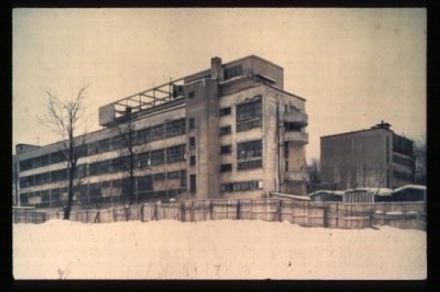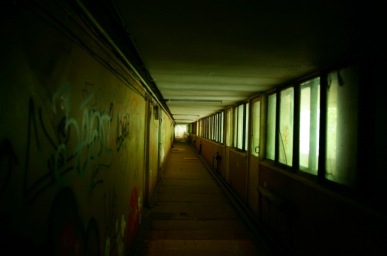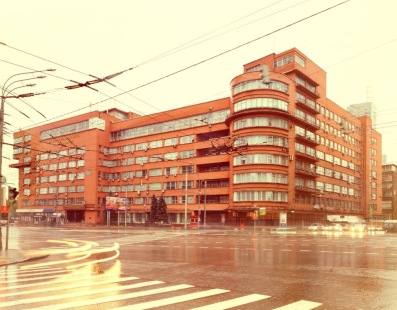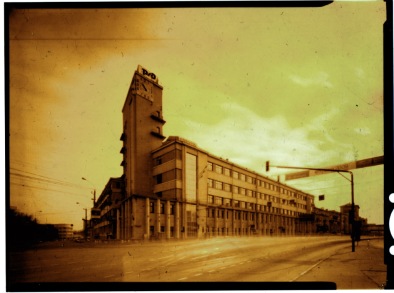.
On December 15th, 2012, Ross Wolfe interviewed Boris Groys, Global Distinguished Professor of Russian and Slavic Studies at New York University. His numerous published books include The Total Art of Stalinism (1986), Art Power (2008), The Communist Postscript (2009), and Going Public (2011). What follows is an edited transcript of their conversation.
.
Ross Wolfe: In the introduction to your 2006 book, The Communist Postscript, you provocatively assert: “The communist revolution is the transcription of society from the medium of money to the medium of language. It is a linguistic turn at the level of social praxis.â€[1] What do you make of the “communist turn†in contemporary left discourse, that is, the return to the idea of communism in Badiou, Žižek, Bosteels, Dean, et al.?
Boris Groys: It doesn’t seem to me that any return has actually taken place. If you are speaking now of the West, not of the East, then you have always had communist parties: the French Communist Party, the Italian Communist Party, every European nation had a communist party during and after the Cold War. So I would rather speak about a migration of discourse away from the framework of mass parties. These became inefficient, partially dissolved, and lost their influence and power within European societies. And now we have groups of intellectuals who are asserting their hegemony over the discourse of the “communist hypothesis.â€

French leftistsJean-Paul Sartre and Michel Foucault, 1972.
Gilles Deleuze can be seen in the background
But we also shouldn’t underestimate the influence or the intellectual and institutional power of the mass party. The communist party apparatus and communist press were very influential in France and Italy throughout the Cold War. And then, if we look at the intellectual trajectories of different figures, from Sartre to Foucault and Derrida and so on, all of them in one way or another defined his position in the first place vis-à -vis the Communist Party, much more so than in relation to capitalism. So if you look at the career of Badiou, for example, he began with a kind of Sartrean connection, but then developed a Maoist infatuation very early on, in the 1960s. His project since then was one of constant revolt against the domination of the French Communist Party. The Maoist movement, like many others from that time, was actually directed against the leading role of the Communist Party. Everything that we read now from Badiou and others comes out of this very early experience of French Maoism in the 1960s. They experienced the “betrayal†of the 1960s movements by the Communist Party, even though these movements had been partially directed against the communist parties to begin with. We can argue what happened in different ways, but my impression is that right now we have the continuation of an immanent contestation of the communist party that started much, much earlier — in the 1960s.
On the other hand, I was and still am very interested in the institutional and official traditions of communism. As with the early Protestants who saw the Catholic Church as the church of Satan, communists today claim, “All these decades and centuries of communist movements — that was not real communism. Communism will begin with us.†It is a claim that one can understand, but it seems to me historically, ideologically, politically, and philosophically problematic. All of the theorists of communism today say: “We start anew. We reject everything that came before. We don’t interpret or correct it — we just reject it as a fundamental failure.â€
RW:Â Just as the theorists of communism at present would say that all past forms of communism were the work of Stalin?
BG: They reject Stalin in favor of the idea of communism. But how is one to access this “idea†of communism? To stress the immediate idea of communism is idealistic and neglects the necessity of dealing with the materialist side of communism. Communism is not God. One cannot be a Saint Paul of communism. Sartrean existentialism, Maoist event, or Deleuzean direct contact with energies, desires, affects — these all claim to provide an unmediated understanding of what communism is beyond any tradition, institution, or party. They’re direct, individual, ultimately involving only one person. That is a very Romantic, almost mystical-religious approach. Because, of course, traditionally Marxism has something to do with mediation and a disbelief in the possibility of directly grasping something like “the idea of communism,†or of experiencing communism as an event.

Portrait of Iosif Stalin (late 1920s)
RW: You also argue that the emphasis on the “idea†of communism leads to “a modern form of Platonism in practice.â€[2] What is specifically “modern†about communism?
BG:Â For me, Platonism does not refer to the possibility of immediately grasping the Idea, but rather to a demonstration of the impossibility of any such insight. What the Socratic dialogues demonstrate is the impossibility of the notion of a human being grasping the Idea because every course of argumentation collapses on itself. And this place of collapse is actually a site of power. If you look at the Platonic state, the philosopher-king is someone who actually manages and administers this space of collapse, the defeat of the desire for truth. Historically this site was the Soviet Union. What makes this a modern experience is the extreme scale on which it takes place.
We are living in a society that is split in such an obvious way that we no longer believe in the possibility of democracy, at least from a liberal perspective, because there seems to be no hope for consensus, which is the traditional basis of democracy. If you look at contemporary American society, or really any contemporary society, it is so fundamentally fragmented it seems incapable of reaching consensus. Such societies can only be administered, but cannot be brought to any kind of democratic politics. In the West, this kind of administration — in these societies beyond consensus — occurs through the market. But in the East, the market was ultimately abolished by the Bolsheviks. And so instead of being governed by economics, there was an emergence of certain kinds of administrative power practicing a language beyond consensus. The phenomenon of a language where no agreement can be reached is precisely what one can find in a very refined form in the Platonic dialogues. And the philosopher here is someone who manages language beyond consensus. What makes the Platonic problem modern is that it has became urgent and political, a problem of society as a whole, rather than of a small group of Greek intellectuals in the agora.
In Plato, the state is administered by the philosophers through an occasional application of violence, not determined by any consensus, because Plato understands that such consensus is impossible. So both capitalism and communism, especially in their Eastern European form, constituted answers to the insight that the French Revolution’s bourgeois dream of reaching a sort of basic consensus had collapsed. The dream had collapsed already by the time of Marx, and then even further with Nietzsche. As long as you speak about commonalities or “the common,†you remain at the level of reflection, which is fundamentally pre-Marxist. If you want to speak of politics after Marx, after Nietzsche, after Freud, you have to consider societies that have nothing in the way of common ground. Because if you look at the intellectual landscape before the French Revolution, and even slightly afterward, you find this kind of hope for a consensual politics or ideology. There’s a belief in a natural truth, a divine truth, a common truth, a truth that’s reached at the end of history. But a new, modern period of political thinking commences from a dissatisfaction with such truths. When the class struggle asserts itself the possibility of reaching consensus or a common truth disappears. How does society manage that? There are two models: the state and the market. They manage the problem in two different ways.

Crowds gather for Maiakovskii’s funeral, 1930
RW:Â With management by the state being socialism and management by the market being capitalism?
BG: A socialist state exists only where the state has been liberated from the market — in which the market has been either subordinated or eliminated entirely. In a capitalist state, say, in the West, the state is subordinated to the market. So what was the Stalinist state? It was a machine for the frustration of everybody, in which the possibility of achieving the truth was excluded. And what is the Western market? The same. It’s a machine for the frustration of everybody, since everyone knows that whatever a politician says, nothing will come out of it.
RW: As an author of one of the books on communism for Verso: How central was Marx’s thought to the formulation of communism? Obviously there were pre-Marxist communists such as Saint-Simon or Fourier or Proudhon. And later there were non-Marxist (anarchist, post-Marxist) developments or articulations of the idea of communism. But with respect to your own work the question is different, I think, in that more than the irreducibility of Marx, it asserts the irreducibility of Stalin.
BG: I would argue for irreducibility of both, and that of Marx, I have summarized already. All these thinkers you mention — Saint-Simon, Fourier, and so on — proposed improvements that were based on the possibility of consensus, on the hope of reaching a common understanding, the insight that life as it is presently is bad, but can be changed from bad to good. Marx believes that such a common understanding is impossible, because of the difference of class interests. He was, basically, anti-utopian.
RW: But didn’t Marx believe in the possibility of a classless society?
BG: Yes, but only after all the classes are suppressed as classes, and this is potentially an infinite process. The traditional utopian communist ideal was based on a perception that one could take all classes, the whole population as it is, and proceed toward a new social truth. Marx argued that this wasn’t possible. For him, one has to start a war inside society, which involved class struggle. A classless society cannot include a huge part of society as it is and that must be therefore destroyed. Stalin’s insight was that a classless society is not something that emerges immediately, spontaneously, or even necessarily, after the abolition of the existing class system. The society that comes after the revolution is also a society that should be managed, which creates its own classes. Now the question is how one deals with that.
Marx starts his discourse with the impossibility of common interest. Everything else comes out of this. Insofar as you believe that there’s something — a “desire,†an “energy,†“absolute spirit,†whatever — that unites society as it is, you’re thinking along pre-Marxist lines. To adopt a post-Marxist lens, you have to see society as something irreparably and irreversibly divided. For this kind of outlook, the question becomes how one manages this division. How does one operate under the assumption (or actually the reality) of this irreparable divide? That is the post-Marxist problem.

Soviet premier Stalin and American president Roosevelt
fraternizing at the Yalta conference, February 1945
RW: To rephrase things slightly: Would you say that Marx’s thought is the necessary presupposition or the condition of possibility for communism? And then, conversely, would you say that Stalin is the necessary outcome of communism?
BG: No, I wouldn’t say all of that, for there isn’t any single answer to this question. Stalin is an answer. Is it a plausible answer? Yes. Is it a likeable answer? Well, no, it’s not. But it’s not an answer that can be ignored. The market doesn’t provide an adequate answer. Stalin doesn’t provide an adequate answer either, at least, not the answer I would prefer. But at the same time, I don’t believe that any answer can be sufficient if it ignores the question, and all its radical implications.
RW: Toward the beginning of your book, Going Public, you refer to “the period of modernity†as “the period in which we still live.â€[3] You roughly date it, at least theoretically and philosophically, as coinciding with Kant’s Critique of Judgment (1790). The obvious political correlate to this would be 1789 and the French Revolution. Are we still — or were we ever — postmodern? If so, how does this relate to modernity, “the period in which we still liveâ€? Might postmodernity perhaps be reaching an end?
BG: Well, when I speak about postmodernity in my writings, it’s because other people use this word and believe themselves to have a certain understanding about what it means. Personally, I don’t think any such transition from modernity to postmodernity ever happened. Postmodernity has never really had any meaning as a concept.
Postmodernism was associated with disbelief in progress. But nobody in the nineteenth century who was intelligent believed in progress. Baudelaire didn’t believe in progress and neither did Flaubert, nor Nietzsche, or Wölfflin. “Postmodernity†was a way by which people came to understand what people already understood in the nineteenth century.
But perhaps it was only known at first by avant-garde intellectuals, elite circles of artists in Western Europe during the nineteenth century. When people speak of postmodernity, they’re really talking about something that was known before but now was becoming clear to everybody. From the perspective of artistic, intellectual, and cultural modernity, however, nothing has changed. And we still don’t know how to deal with it. Modern problems, as they were formulated in relation to art, culture, and writing, during the nineteenth century, remain very relevant and unsolved. The real change came toward the middle of the nineteenth century. It occurred with the collapse of Hegelianism, the collapse of European idealism amidst the industrial revolution, and with it, the beginning of intellectual and cultural modernity.
But almost as early as the disjunction between Romanesque and Gothic churches, if you will, you’ll always see these “waves†in the succession of European styles. So beginning with the Renaissance, you have clear-cut forms, geometrical models, and a certain kind of clarity or intellectual transparency. But then it’s followed by the Baroque period: by complexity, obscurity, and contradiction. Then you have something similar between Classicism and Romanticism. And then at the start of the twentieth century, there is the avant-garde, which lasted until 1926 or 1927. After that, though, there is this huge wave of embryonic postmodernity — historicism, Socialist Realism, Nazi art, the “return to order,†and the Novecento in Italy. But all of that was suppressed after World War II. Following the war, there’s a new wave of modernism — a neo-avant-garde that goes from the 1950s and 1960s, lasting through the early 1970s. Starting in 1971 or 1972, you get a kind of neo-baroque. There’s Of Grammatology by Derrida, a baroque gesture. So there are these waves in the cultural history of Europe, shifting from clarity, intellectual responsibility, mathematico-scientific influences, and transparency to opacity, obscurity, absence, infinity. What is the Deleuzean or Derridean moment? It’s the moment where they took the structuralist models, defined as a system of finite rules and moves, and made it infinite. It is precisely what Romanticism did with the Enlightenment, what the Baroque did with the Renaissance, and so on. Even in terms of Marxism, you get these waves. There is the classical period of clarity. Then there is a period of obscurity — Benjamin, Adorno, and the like.
RW: A related question: How would you say the Soviet project relates to the modern period? Do you think there’s any sort of link between what’s understood in the West — perhaps wrongly — as “postmodernity†and the collapse of historical Marxism in the 1970s and, after 1989, the dissolution of the Soviet Union? Is there any correlation between the post-Soviet moment and the general onset of postmodernity?
BG: Just as I don’t believe in “postmodernity,†I don’t believe in the “post-Soviet†situation either; rather, we are experiencing an intermediate moment between two periods of wars and revolutions. Today we live under the illusion of peace and free markets, just like people did during the nineteenth century, before the First World War. Our current mode of existence is very similar to the second half of the nineteenth century: there is mass culture, entertainment instead of high culture, terrorism, an interest in sexuality, the cult of celebrity, open markets, etc.
Before the rise of Imperial Germany, everybody in the West believed it was interested in capitalism, although in Germany everyone understood it was about war. That is what will happen again in the foreseeable future. In fact, it is already beginning to happen, in that we are actually witnessing a return to a state and military infrastructure. Just as after the French Revolution, there is the reversion to antiquity, and then a new medievalism with Romanticism, the infrastructure of our epoch will be contested, and this will start a new period of war and revolutions. At that point, we’ll remember the Soviet Union, and many other phenomena. |P
Notes
1. Boris Groys, The Communist Postscript (London: Verso, 2009), xv.↑
2. Ibid., 2.↑
3. Boris Groys, Going Public (New York: Sternberg Press, 2010), 10.↑































































